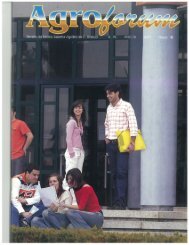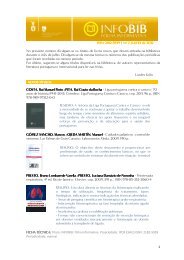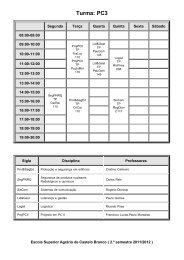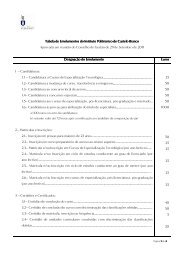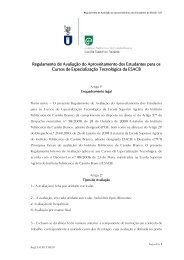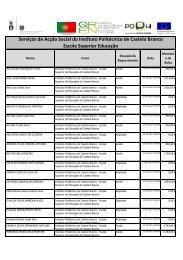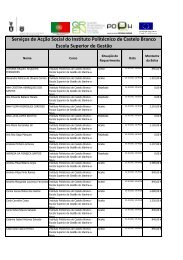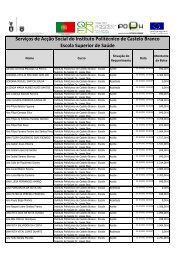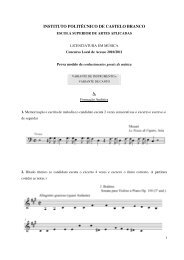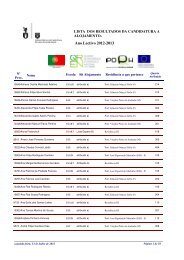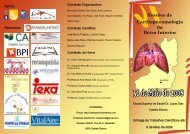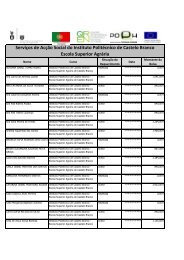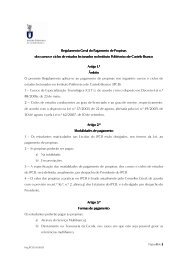N.º 24 - PDF - Instituto Politécnico de Castelo Branco
N.º 24 - PDF - Instituto Politécnico de Castelo Branco
N.º 24 - PDF - Instituto Politécnico de Castelo Branco
You also want an ePaper? Increase the reach of your titles
YUMPU automatically turns print PDFs into web optimized ePapers that Google loves.
market, following for France, England and Italy.<br />
The tra<strong>de</strong> is above all driven through Germany, where<br />
they are most of the great companies importers.<br />
In Europe more than 2000 species are used with commercial<br />
ends; The species more cultivated are: laven<strong>de</strong>r,<br />
pity-opium and fennel. The larger cultivations in CE: are in<br />
France, Hungary, Germany and Spain. In no CE countries<br />
the greater cultivations are in Bulgaria and Albania.<br />
European German companies, dominate the global<br />
medicinal and aromatic plant sector. There are about 20<br />
major wholesalers of MAPs and seven agents. There is an<br />
increasing interest in organic certified MAPs and about<br />
half of the importers and wholesalers also <strong>de</strong>al in organic<br />
plant material *although the quantities are small compared<br />
to conventional products. Only very few importers and<br />
processors <strong>de</strong>al only in organic MAPs and spices<br />
1. Definition of Medicinal and<br />
Aromatic plants (MAP)<br />
The origin and the use of the medicinal and aromatic<br />
plants are ol<strong>de</strong>r than the agriculture, once the vegetable<br />
medicine is as primitive as the man. The biblical references<br />
about aromatic plants and medicine ayurvedic are numerous<br />
and contemplate the fiction of oriental cultures about<br />
perfumes, medicinal applications, culinary utilization and<br />
the unguent to embalm.<br />
In first place we are going to <strong>de</strong>fine medicinal, aromatic<br />
and culinary plants, because this terms are such used<br />
indiscriminately.<br />
Medicinal Plants are the lot of vegetable plants that<br />
elaborate in one or in several organs secondary metabolites<br />
or beginnings actives capable to alter the physiologic<br />
functions of the animal organisms (ex: chamomile; lime;<br />
ginseng; vervein and angelica root)<br />
Aromatic Plants is a sub group of the medicinal plants,<br />
whose actives are constituted total or partially for essential oils<br />
of volatile nature (ex: rose; geranium; laven<strong>de</strong>r and jasmine).<br />
Spicy or culinary plants is a sub group of the aromatic<br />
plants, used by the conservators and organoléptics properties<br />
that check to the foods and drinks.<br />
In this group we also have the spices and the herbs.<br />
Herbs are •herbaceous plants, leaves, flowers and stems.<br />
We use them in green and in dry or the essential oil.<br />
They are from temperate areas, and they have lowers% of<br />
essential oils (parsley; corian<strong>de</strong>r; mint; oregano and basil)<br />
Spices are vegetable products, peels of trees, rhizomes,<br />
flowers, fruits, or seeds. They are used in dry and are from<br />
tropical and sub-tropical areas. They have discharges% of<br />
essential oils ( ex. cloves; paprika; ginger; pepper, cinnamon<br />
and vanilla)<br />
We also have some other group of plants that we use as<br />
pestici<strong>de</strong>s, repellent, colouring and stimulating plants.<br />
2. Environmental and social assessment<br />
In the world the MAP repartition <strong>de</strong>pends on ecological<br />
factors, like clime, and soils. Some species are calcicoles<br />
or calcifuges and others can stand different kind of pH in<br />
the soil. The clime is a factor of vital importance, principally<br />
for the temperature, humidity and light.<br />
The Mediterranean countries are rich in different landscapes<br />
and ecosystems and have a high biodiversity. The<br />
collection of wild medicinal and aromatic plants has been<br />
important for centuries.<br />
The MAP sector is dominated, on the production si<strong>de</strong>,<br />
by traditional wild collection, including more then 100,000<br />
families as groups in rural areas.<br />
The safety and quality of raw medicinal plant material<br />
and finished products <strong>de</strong>pend on factors that may be classified<br />
as intrinsic (genetic) or extrinsic (environment, collection<br />
methods, cultivation, harvest, post-harvest processing,<br />
transport and storage practices). Inadvertent contamination<br />
by microbial or chemical agents during any of the production<br />
stages can also lead to <strong>de</strong>terioration in safety and quality.<br />
Medicinal plants collected from the wild population<br />
may be contamination or have intentional adulteration, all<br />
of which may have unsafe consequences. As a matter of<br />
fact, very heterogeneous raw material will be found on the<br />
market never meeting the quality requirements. Furthermore,<br />
trained collectors are rare and, for this reason, the<br />
i<strong>de</strong>ntity of the plant material cannot always be guaranteed.<br />
The collection of medicinal plants from wild population<br />
can give rise additional concerns related to global, regional<br />
and/or local over-harvesting, and protection of endangered<br />
species. Safety and quality assurance measures are nee<strong>de</strong>d<br />
to overcome these problems and to ensure a steady, affordable<br />
and sustainable supply of medicinal plant materials<br />
of good quality. In recent years, good agricultural practices<br />
have been recognized as an important tool for ensuring the<br />
safety and quality of a variety of food commodities, and<br />
many Member states have established national good agricultural<br />
practice gui<strong>de</strong>lines for a range of foods. However,<br />
quality control for the cultivation and collection of medicinal<br />
plants as the raw material for herbal medicines may<br />
be more <strong>de</strong>manding than that for food production, possibly<br />
for this reason, only China, the European Union, and Japan<br />
have recently <strong>de</strong>veloped gui<strong>de</strong>lines on good agricultural<br />
practices for medicinal plants.<br />
6<br />
n.º <strong>24</strong> Ano 18, 2010



